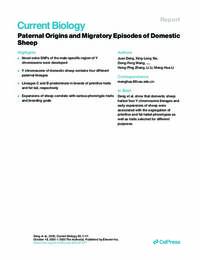Authors:
Juan Deng
Xing-Long Xie, Xing-Long Xie, Dong-Feng wang, Dong-Feng wang, Chao Zhao, Chao Zhao, Feng-Hua Lv, Feng-Hua Lv, Xin Li, Xin Li, Ji Yang, Ji Yang, Jia-Lin Yu, Min Shen, Min Shen, Lei Gao, Lei Gao, Jing-Quan Yang, Jing-Quan Yang, Ming-Jun Liu, Wen-Rong Li, Yu-Tao Wang, Feng Wang, Jin-Quan Li, Eer Hehua, Yong-Gang Liu, Zhi-Qiang Shen, Yan-Ling Ren, Guang-Jian Liu, Ze-Hui Chen, Ze-Hui Chen, Neena A Gorkhali, Hossam E Rushdi, Hosein Salehian-Dehkordi, Hosein Salehian-Dehkordi, Ali Esmailizadeh, Maryam Nosrati, Samuel R. Paiva, Alexandre R Caetano, Ondřej Štěpánek, Ingrid Olsaker, Christina Weimann, Georg Erhardt, Ino Curik, Juha Kantanen, Joram Mwashigadi Mwacharo, Joram Mwashigadi Mwacharo, Olivier Hanotte, Olivier Hanotte, Michael W Bruford, Michael W Bruford, Elena Ciani, Kathiravan Periasamy, Marcel Amills, Johannes A Lenstra, Han Jianlin, Han Jianlin, Hong-Ping Zhang, Li Li, Meng-Hua Li, Meng-Hua Li
The domestication and subsequent global dispersal of livestock are crucial events in human history, but the migratory episodes during the history of livestock remain poorly documented [1, 2, 3]. Here, we first developed a set of 493 novel ovine SNPs of the male-specific region of Y chromosome (MSY) by genome mapping. We then conducted a comprehensive genomic analysis of Y chromosome, mitochondrial DNA, and whole-genome sequence variations in a large number of 595 rams representing 118 domestic populations across the world. We detected four different paternal lineages of domestic sheep and resolved, at the global level, their paternal origins and differentiation. In Northern European breeds, several of which have retained primitive traits (e.g., a small body size and short or thin tails), and fat-tailed sheep, we found an overrepresentation of MSY lineages y-HC and y-HB, respectively. Using an approximate Bayesian computation approach, we reconstruct the demographic expansions associated with the segregation of primitive and fat-tailed phenotypes. These results together with archaeological evidence and historical data suggested the first expansion of early domestic hair sheep and the later expansion of fat-tailed sheep occurred ∼11,800–9,000 years BP and ∼5,300–1,700 years BP, respectively. These findings provide important insights into the history of migration and pastoralism of sheep across the Old World, which was associated with different breeding goals during the Neolithic agricultural revolution.
Citation:
Juan Deng, Xing-Long Xie, Dong-Feng wang, Chao Zhao, Feng-Hua Lv, Xin Li, Ji Yang, Jia-Lin Yu, Min Shen, Lei Gao, Jing-Quan Yang, Ming-Jun Liu, Wen-Rong Li, Yu-Tao Wang, Feng Wang, Jin-Quan Li, Eer Hehua, Yong-Gang Liu, Zhi-Qiang Shen, Yan-Ling Ren, Guang-Jian Liu, Ze-Hui Chen, Neena A Gorkhali, Hossam E Rushdi, Hosein Salehian-Dehkordi, Ali Esmailizadeh, Maryam Nosrati, Samuel R. Paiva, Alexandre R Caetano, Ondřej Štěpánek, Ingrid Olsaker, Christina Weimann, Georg Erhardt, Ino Curik, Juha Kantanen, Joram Mwacharo, Olivier Hanotte, Michael W Bruford, Elena Ciani, Kathiravan Periasamy, Marcel Amills, Johannes A Lenstra, Han Jianlin, Hong-Ping Zhang, Li Li, Meng-Hua Li. (19/10/2020). Paternal Origins and Migratory Episodes of Domestic Sheep. Current Biology, 30 (20), pp. 4085-4095.
Keywords:
y-chromosome
mitogenome
whole genome
primitive traits
fat-tailed
migration
sheep
domestication
wool

